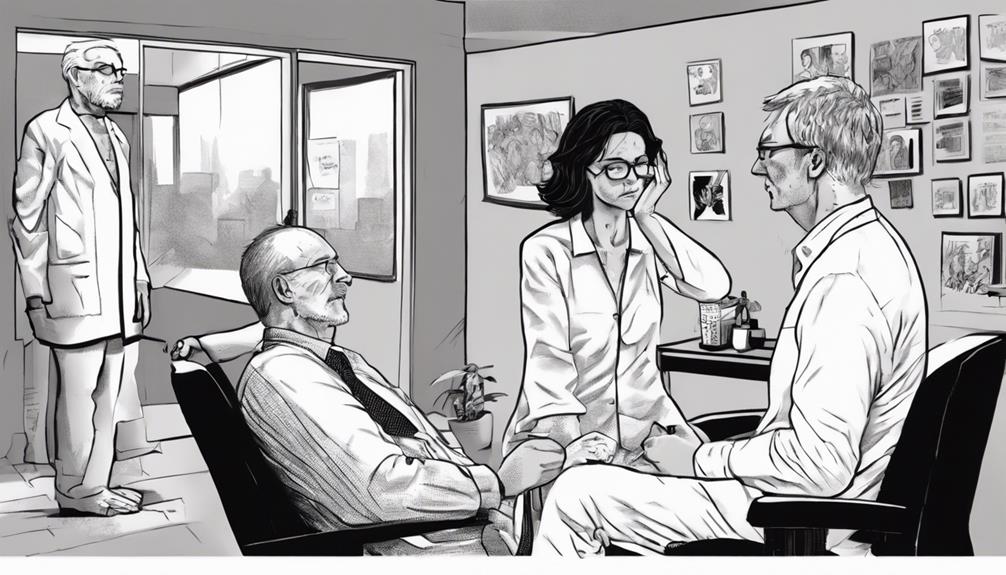Explore potential risks with somatic therapy: boundary violations or re-traumatization are dangers. Beware regression from insufficient training, hindering progress. Emotional vulnerability and dependency may leave you in an unsafe state. Discomfort when delving into profound emotions is common; therapists aim for secure exploration to foster healing. Emotional overwhelm might surface underlying emotions; sensitivity is part of the journey. Proper management and skilled therapists mitigate re-traumatization risks effectively. Open communication is key for trust-building. Address boundaries to guarantee safety in therapy sessions. Once aware, you can navigate these challenges for better therapeutic outcomes.
Key Takeaways
- Risk of misinterpretation and boundary violations in touch therapy.
- Emotional discomfort and overwhelm when exploring deep-seated emotions.
- Concerns of re-traumatization if past traumas resurface inadequately.
- Importance of open communication to establish trust and boundaries.
- Ensuring a safe therapeutic environment with clear boundaries and supervision.
Risks of Somatic Therapy

When considering somatic therapy, it's crucial to be aware of the potential risks involved in the treatment process. Risks of somatic therapy include the possibility of misinterpretation of touch, which can lead to boundary violations and re-traumatization for the client.
Inadequate training in somatic therapy may result in therapists using inappropriate touch or techniques that induce regression, ultimately harming the individual seeking help. Such mismanagement can break down psychological defenses, leaving the client in a state of emotional vulnerability and dependency.
Furthermore, inappropriate regression during somatic therapy sessions can hinder progress by fostering infantile behaviors rather than promoting healing. The risk of re-traumatization in somatic therapy is also prevalent, as poorly managed sessions can prolong the negative impact of the original trauma, emphasizing the critical need for careful and ethical therapeutic interventions to guarantee the safety and well-being of the client.
Potential Discomfort During Sessions

During somatic therapy sessions, clients may encounter discomfort as they explore deep-seated emotions and physical sensations. The process of delving into and releasing stored trauma within the body can be intense, sometimes triggering overwhelming feelings and bringing forth painful memories.
This exploration of challenging emotions can lead to emotional distress during sessions. It's important to acknowledge that discomfort in somatic therapy is a natural part of the healing process, as individuals confront and process repressed emotions.
Therapists play a vital role in creating a safe environment for clients to navigate these uncomfortable feelings. By establishing a supportive space, therapists can help individuals work through the discomfort that arises during somatic therapy sessions. This safe setting allows clients to explore their deep-seated emotions and physical sensations with guidance and care, facilitating their journey towards healing and emotional well-being.
Emotional Overwhelm and Sensitivity

Exploring deep-rooted emotions and physical sensations in somatic therapy can often lead to emotional overwhelm and increased sensitivity as buried emotions resurface. During somatic therapy sessions, individuals may find themselves facing a flood of emotions that can be challenging to manage.
This emotional overwhelm can stem from the stirring up of past traumas or unresolved issues, intensifying emotional reactions and leaving you feeling emotionally raw. As you delve into these intense emotional experiences, it's important to remember that heightened emotional sensitivity is a common aspect of somatic therapy.
Your therapist is there to provide support and guidance as you navigate through these overwhelming feelings. By acknowledging and addressing the buried emotions that have been brought to the surface, you can begin to process emotional overwhelm in a safe and constructive manner. Remember, it's all part of the healing journey toward greater emotional well-being.
Re-traumatization Concerns

What risks are associated with re-traumatization in somatic therapy sessions?
Re-traumatization in somatic therapy can occur when past traumas resurface, triggering distressing emotions and prolonging the negative impact of the original trauma. Additionally, inappropriate regression during therapy sessions may lead to clients feeling overly dependent or regressing to a childlike state, hindering their progress.
Skilled therapists play an essential role in mitigating the risks of re-traumatization. They must possess the expertise to navigate sensitive emotional territory and provide appropriate support to clients. Adequate supervision and adherence to training standards are essential in ensuring that therapists are equipped to handle situations that may lead to re-traumatization.
It is vital that therapists maintain a balance between exploring past traumas and ensuring that clients feel safe and supported throughout the somatic therapy process. By being attuned to the potential risks of re-traumatization and employing effective therapeutic techniques, therapists can help clients heal without causing further harm.
Importance of Open Communication

Open communication plays a crucial role in somatic therapy, nurturing trust and understanding between clients and therapists.
In the field of somatic therapy, open communication is essential for creating a safe space where clients can openly express their needs, boundaries, and concerns.
By engaging in transparent dialogue, clients can effectively communicate their emotions, experiences, and physical sensations to their therapists, ensuring that the therapy process is customized to their unique needs.
Through open communication, misunderstandings and misinterpretations can be minimized, reducing the risk of harm during somatic therapy sessions.
Clients who feel empowered to voice their thoughts and feelings are more likely to establish a strong sense of trust with their therapists, leading to a supportive environment for exploring and processing somatic experiences.
As a result, maintaining open communication channels is crucial for enhancing the therapeutic relationship and promoting positive outcomes in somatic therapy sessions.
Ensuring Safe Therapeutic Environment

To maintain a safe therapeutic environment in somatic therapy, it's vital to address potential risks and establish clear boundaries for client safety. Without a safe space, negative effects such as inappropriate regression and re-traumatization can occur, leading to harm instead of healing. Risks like misinterpretation of touch or inadequate supervision can further exacerbate these potential negative effects. Adequate training standards and professional guidance are essential in creating a secure therapeutic setting that minimizes the chances of inappropriate regression, which could result in issues like infantile dependency.
Ensuring a safe therapeutic environment involves being vigilant about boundaries, communication, and recognizing warning signs of potential harm. Addressing risks promptly, such as abusive touch or unsafe practices, is essential in maintaining a safe space for clients in somatic therapy.
Frequently Asked Questions
What Are the Dangers of Somatic Experiencing?
You have to understand the dangers of somatic experiencing. Improper application can re-traumatize you. Inadequate training may lead to harm. Risks include breakdown of defenses and fostering dependency. Stay safe by ensuring therapists follow ethical guidelines.
What Are the Disadvantages of Somatic Therapy?
When considering the disadvantages of somatic therapy, remember potential high costs, risks of inappropriate touch, re-traumatization if not handled carefully, negative outcomes due to inadequate training, and limited empirical evidence compared to traditional therapies.
Is Somatic Experiencing Legit?
Is Somatic Experiencing legit? Absolutely! Developed by Dr. Peter Levine, it effectively treats trauma and stress-related disorders by releasing trapped energy. Research backs its efficacy in reducing PTSD symptoms. Many find relief through this therapy.
How Do You Feel After Somatic Experiencing?
After somatic experiencing, you may feel more grounded, connected, and empowered. Emotional release like crying or shaking can happen as trapped trauma is processed. Improved sleep, reduced anxiety, and overall well-being are common post-session feelings.
Conclusion
To sum up, while somatic therapy can have powerful benefits, it's important to be aware of potential negative effects. Just like a stormy sea, the waters of emotional healing can be turbulent, causing discomfort, overwhelm, and even re-traumatization.
By maneuvering these risks with open communication and in a safe therapeutic environment, you can weather the storm and emerge stronger on the other side. Stay mindful, stay safe, and keep sailing towards healing.










